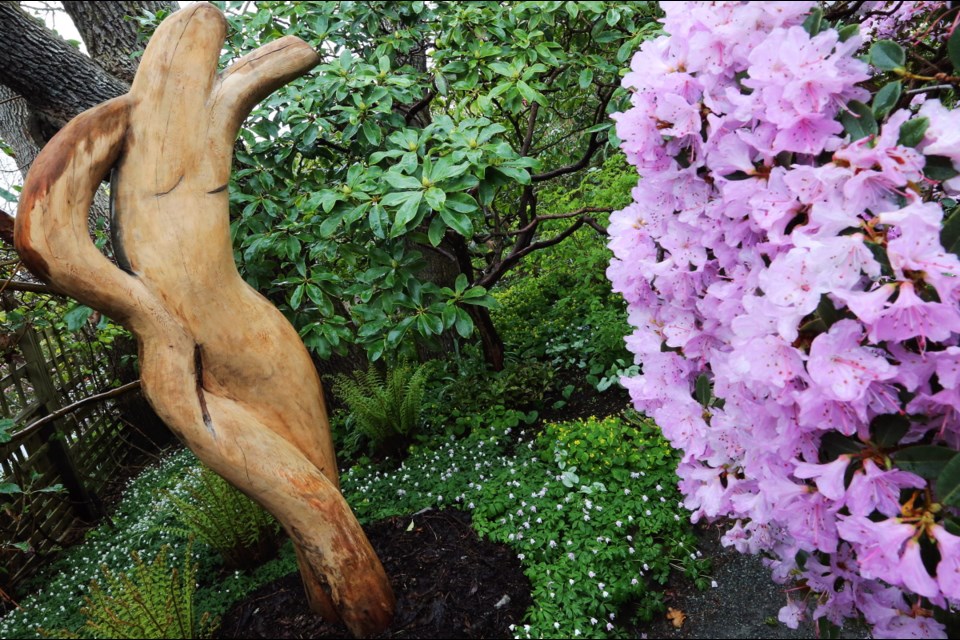In Japan, the peak of blossom time is a day called Hanami. It’s time for a huge outdoor street party. Victoria’s streets are planted with many varieties of “cherry blossoms,” actually a sterile plum tree that the Japanese call sakura. Our city puts on quite a show, the greatest installation of public art we have. Let’s name the date and in the future we can celebrate Hanami, too.
Actually, sakura season is mostly behind us. The rhododendrons of Finnerty Gardens at the University of Victoria and the rhodos and wild flowers at Abkhazi Garden in Fairfield are taking centre stage. This year, Abkhazi has teamed up with the Celia Duthie Gallery on Saltspring Island and now the garden is set with eight large figurative sculptures by Michael Dennis. As you set out in search of carvings titled Muses, you’re in for a mystery tour of art and flowers.
Dennis, of Denman Island, has a sculptural style ideally suited to the task. He works with big chunks of cedar, mostly two metres tall. These have an internal growth dynamic that he discovers, and then refines, to suggest a human form. The result is never overstated. The contraposto of a turned hip or the simple suggestion of shoulder is enough to inspire the viewer’s imagination. When Dennis begins to identify a head or give definition to breasts, he may have gone too far. “I try to capture the essence of human gesture from a tree or other material using only the minimum definition required,” Dennis has said.
Among the cedar pieces are a few cast in bronze, whose subtle colour is not much different from weathered wood. To see more of Dennis’s work, visit the Celia Duthie Gallery — with its outdoor sculpture park! It’s at 125 Churchill St., Saltspring Island, 250-537-9606, duthiegallery.com.
On the ground floor of the University of Victoria’s library (now known as the Mearns Centre for Learning) is a fine little display space named the Maltwood Prints and Drawings Gallery. It is used for joint projects between the university art collections and the library’s special collections and archives. Currently, the subject is Margaret Peterson.
Peterson (1902-1994) was an artist of sweeping vision and towering visual power — except for Emily Carr, she’s the best we’ve ever had. She lived here for much of her life, and her estate was divided between the Art Gallery of Greater Victoria and the University of Victoria. The University owns a number of paintings and her “papers” — her sketches, photos, art supplies, books and thousands of pages of manuscript from as-yet unpublished books. This show is the first chapter in the rediscovery of one of our finest artists.
Peterson was born in Seattle and had a brilliant career as student and then professor of painting at University of California at Berkeley (1922-1950). She was cut off in her prime by her refusal to sign a “loyalty oath” during the McCarthy era, stating that she was not a communist. With her husband, writer Howard O’Hagan, she took up residence at the mouth of the Cowichan River and soon moved into Emily Carr’s last home on St. Andrews Street. With the exception of 10 years spent on an island north of Sicily, Victoria was her home.
Peterson had numerous solo shows at the Art Gallery of Greater Victoria and represented Canada at the Sao Paolo Biennale in 1963. She valued her own paintings, and didn’t let them go easily. Once again, we discover an artist — a terrific one — whose reputation did not develop and whose work was not widely seen. It is clearly time for a re-evaluation.
The show is curated by graduate student Justine Drummond, a B.C. Arts Council Curatorial Co-op intern. She deserves an A+ for selecting art and artifacts to sketch out the story, including stone carvings from Central America, the artist’s powdered pigments and a portrait of her from 1936 by celebrated photographer Imogene Cunningham. It is always a pleasure to see local art history taken seriously.
A message was slipped under my door: “Artist shunned by critic for 30 years! Redress sought. I can make things difficult for you!” Attached was an invitation to Creative Bonds, an exhibition by four women at the Community Arts Council of Greater Victoria’s gallery at the Cedar Hill Rec Centre. I’ve seen the show, and it’s a good one, featuring quilts by Kathleen Little and paintings by Erin Chard, Judy McLaren and Sarah Amos. Amos, an excellent painter, says it’s not fair that she can’t get a review just because she’s married to the critic. And why should her friends suffer for this? Good point. Go see their show.
How are your summer plans shaping up? The Metchosin International Summer School of the Arts is ready to open, from June 28 to July 11. MISSA, an inspiration of Robin Hopper, began one summer 30 years ago at Pearson College at Pedder Bay. It was a place to hold pottery workshops and instantly grew bigger. This year, dozens of courses in different media are offered, varying in length from one day to two weeks. For the best effect, move into a dormitory, take your meals with your colleagues, and come away from beautiful Metchosin brimming with new techniques and ideas.
Gelatin monotype? Sculptural basketry? Oil on copper? There are also courses on voice, storytelling, fidding and more. Visit missa.ca or phone 250-391-2420.
Michael Dennis: Muses, at Abkhazi Garden, 1965 Fairfield Rd., through 2014.
Margaret Peterson: A Search in Rhythm, at the Mearns Center for Learning, UVic.ca/library or 250-721-6562, until Aug. 18.
Creative Bonds: Four Women, at Community Arts Council Gallery at Cedar Hill Rec Centre. Reception April 24, 5.30 to 8 pm. For details, call 250-389-0303, until April 29.
Metchosin International Summer School of the Arts, www.missa.ca or 250-391-2420
